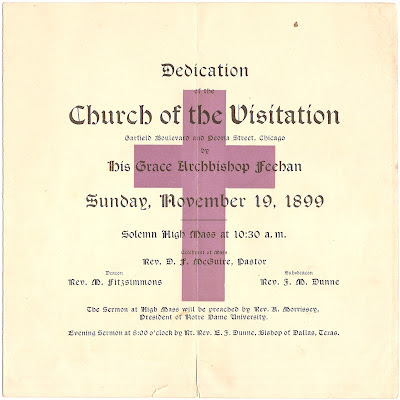Every time I come across a concert program in the files of
Agnes Tully Stevens’ belongings, I hope it will be the missing item that shows
some of the pieces she performed as a violinist while on tour in her younger
years. But each time so far, I’ve been generally disappointed.
The simple program I pulled out of the stack for today’s
post is no different. Though the paper is full of names of performers, search
as I might, I could not conjure up her name among the list of those talented
Chicagoans of a century ago.
On revisiting the details, though, that would not be
surprising. This particular event took place when Agnes was only eleven years
of age. While parents often start their children’s music lessons at early ages,
one could hardly expect anyone other than a child prodigy to be of
performance-level skill at that age.
Add this program to the tally for early impressions that
formed a person into who she became. Part religious influence, part musical
inspiration, this event was the dedication of a new church (or church building)
not far from the Tully home. Though it was not the family’s own parish—they attended
St. Anne on Garfield Boulevard—it was a neighboring
parish. On the corner of that same street—Garfield Boulevard—and Peoria Street, the Church of the
Visitation was dedicated on one special Sunday in November, 1899.
What a glorious occasion it must have been. There were
morning and evening festivities. None less than the President of Notre Dame University
was there to speak. There were many other dignitaries there to join him. And
the musicians.
Oh, the music! We’ll take a look at the program in tomorrow’s
post, but suffice it to say it must have been worthy of the celebration. How
special that must have been to the young Agnes—special enough, at least, to
impress her to hang on to the program itself for the rest of her life.
I often wonder what thoughts there were to prompt Agnes to
decide to keep such things. What memories were embedded in that paper—invisible
to people of another generation like me, but which sprang to life with one’s
knowing glance at the page? I guess it’s those hidden aspects of an ancestor’s
life that I wish I could resurrect from oblivion with my research. Wouldn’t it
be grand to know those sparks of life that lit up one’s face and allowed that
person to thrive despite all other difficulties?
Pursuit of that impossible quest would, in itself, make quite
a story.
Dedication
of the
Church of the Visitation
Garfield Boulevard and Peoria Street, Chicago
by
His Grace Archbishop Feehan
Sunday, November 19, 1899
Solemn High Mass at 10:30 a.m.
Celebrant of Mass
Rev. D. F. McGuire, Pastor
Deacon
Sub-Deacon
Rev. M. Fitzsimmons
Rev. F. M. Dunne
The Sermon at High Mass will be preached by Rev. A. Morrissey,
President of Notre
Dame University.
Evening Sermon at 8:00 o’clock by Rt. Rev. E. F. Dunne, Bishop of Dallas, Texas.

Back before the days of TV and radio (Parts of what became "radio" was just being invented at this time), this must of been "something to do!"
ReplyDeleteGood point, Iggy. It helps to view these bits of history without our current-day mindset. Back then, even sing-alongs were great entertainment. Everyone played, sang, and shared what they could with each other during social gatherings. It always helped to come to the party prepared :)
DeleteTheir social life was way different back then. Everything revolved around church, school and family. It must have been a wonderful time to live.
ReplyDeleteI recently took in (at the museum) a whole bunch of papers..after the sort I had many programs from plays,festivals and commencements that took place in the early 1900's..a remarkable collection.
I wonder too..why they saved everything..down to the smallest scraps of paper..but I am glad they did:)